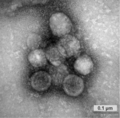Human coronavirus NL63
Human coronavirus NL63 (HCoV-NL63), first identified in late 2004, is a species of coronavirus that infects humans and possibly other primates. It is associated with a range of respiratory symptoms, from the common cold to more severe conditions such as bronchiolitis and pneumonia. HCoV-NL63 is of particular interest in the medical community due to its unique entry mechanism into human cells and its potential implications for understanding and treating other coronavirus infections.
Discovery[edit]
HCoV-NL63 was first isolated in the Netherlands by a team of virologists in 2004 from a 7-month-old child suffering from bronchiolitis and conjunctivitis. The discovery was significant as it added to the growing list of coronaviruses capable of infecting humans, including the previously identified HCoV-229E, HCoV-OC43, and the severe acute respiratory syndrome coronavirus (SARS-CoV).
Transmission[edit]
The virus is primarily spread through respiratory droplets produced when an infected person coughs or sneezes. It can also be transmitted by close personal contact, such as touching or shaking hands, and then touching the mouth, nose, or eyes before washing hands. There is evidence to suggest that HCoV-NL63 can be spread through fomites—objects or materials which are likely to carry infection.
Symptoms[edit]
Infection with HCoV-NL63 can lead to a wide range of symptoms, from none at all to severe respiratory illness. Common symptoms include fever, runny nose, cough, and sore throat. In infants and young children, it can cause croup, an infection of the upper airway, which obstructs breathing and leads to a characteristic barking cough.
Pathogenesis[edit]
HCoV-NL63 uses the angiotensin-converting enzyme 2 (ACE2) receptor to enter human cells, similar to the mechanism employed by the SARS-CoV. This discovery has spurred research into the role of ACE2 in coronavirus infections and the potential for targeting this receptor in treatments.
Diagnosis[edit]
Diagnosis of HCoV-NL63 infection is typically performed using reverse transcription polymerase chain reaction (RT-PCR) from a nasopharyngeal swab. Serological tests to detect antibodies against HCoV-NL63 can also be used to identify past infections.
Treatment and Prevention[edit]
There is no specific antiviral treatment recommended for HCoV-NL63 infection. Management involves supportive care, including rest, fluids, and over-the-counter fever reducers and pain relievers. Prevention strategies are similar to those for other respiratory infections and include frequent handwashing, avoiding close contact with sick individuals, and practicing good respiratory hygiene.
Epidemiology[edit]
HCoV-NL63 is found worldwide and infects people of all ages. It is more prevalent in children and immunocompromised individuals. The virus has a seasonal pattern in temperate climates, with infections peaking in winter and early spring.
Research[edit]
Research on HCoV-NL63 continues to focus on understanding its biology, epidemiology, and clinical implications. Studies on the virus's interaction with the ACE2 receptor are particularly relevant for the development of therapeutic strategies not only for HCoV-NL63 but also for other more severe coronaviruses like SARS-CoV and SARS-CoV-2.
-
Human_coronavirus_NL63
-
Human_coronavirus_NL63
Ad. Transform your life with W8MD's Budget GLP-1 injections from $75


W8MD offers a medical weight loss program to lose weight in Philadelphia. Our physician-supervised medical weight loss provides:
- Weight loss injections in NYC (generic and brand names):
- Zepbound / Mounjaro, Wegovy / Ozempic, Saxenda
- Most insurances accepted or discounted self-pay rates. We will obtain insurance prior authorizations if needed.
- Generic GLP1 weight loss injections from $75 for the starting dose.
- Also offer prescription weight loss medications including Phentermine, Qsymia, Diethylpropion, Contrave etc.
NYC weight loss doctor appointmentsNYC weight loss doctor appointments
Start your NYC weight loss journey today at our NYC medical weight loss and Philadelphia medical weight loss clinics.
- Call 718-946-5500 to lose weight in NYC or for medical weight loss in Philadelphia 215-676-2334.
- Tags:NYC medical weight loss, Philadelphia lose weight Zepbound NYC, Budget GLP1 weight loss injections, Wegovy Philadelphia, Wegovy NYC, Philadelphia medical weight loss, Brookly weight loss and Wegovy NYC
|
WikiMD's Wellness Encyclopedia |
| Let Food Be Thy Medicine Medicine Thy Food - Hippocrates |
Medical Disclaimer: WikiMD is not a substitute for professional medical advice. The information on WikiMD is provided as an information resource only, may be incorrect, outdated or misleading, and is not to be used or relied on for any diagnostic or treatment purposes. Please consult your health care provider before making any healthcare decisions or for guidance about a specific medical condition. WikiMD expressly disclaims responsibility, and shall have no liability, for any damages, loss, injury, or liability whatsoever suffered as a result of your reliance on the information contained in this site. By visiting this site you agree to the foregoing terms and conditions, which may from time to time be changed or supplemented by WikiMD. If you do not agree to the foregoing terms and conditions, you should not enter or use this site. See full disclaimer.
Credits:Most images are courtesy of Wikimedia commons, and templates, categories Wikipedia, licensed under CC BY SA or similar.
Translate this page: - East Asian
中文,
日本,
한국어,
South Asian
हिन्दी,
தமிழ்,
తెలుగు,
Urdu,
ಕನ್ನಡ,
Southeast Asian
Indonesian,
Vietnamese,
Thai,
မြန်မာဘာသာ,
বাংলা
European
español,
Deutsch,
français,
Greek,
português do Brasil,
polski,
română,
русский,
Nederlands,
norsk,
svenska,
suomi,
Italian
Middle Eastern & African
عربى,
Turkish,
Persian,
Hebrew,
Afrikaans,
isiZulu,
Kiswahili,
Other
Bulgarian,
Hungarian,
Czech,
Swedish,
മലയാളം,
मराठी,
ਪੰਜਾਬੀ,
ગુજરાતી,
Portuguese,
Ukrainian


